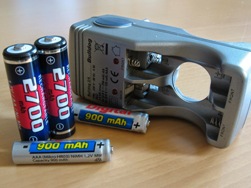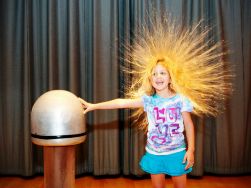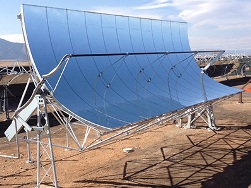Why in different countries the voltage and frequency in the electric network differ
 In the Soviet Union until the 1960s, AC mains voltage had an effective value of 127 volts. In the United States during the same years, the voltage at the outlet reached 120 volts. Later, the current voltage values in the networks will be standardized with changes in order to reduce copper consumption for wires, because for transmitting the same electric power, the smaller the cross-section of the wires is, the smaller the current, and the current in the wire will be the smaller, the higher the voltage at transmission.
In the Soviet Union until the 1960s, AC mains voltage had an effective value of 127 volts. In the United States during the same years, the voltage at the outlet reached 120 volts. Later, the current voltage values in the networks will be standardized with changes in order to reduce copper consumption for wires, because for transmitting the same electric power, the smaller the cross-section of the wires is, the smaller the current, and the current in the wire will be the smaller, the higher the voltage at transmission.
However, this transition will not happen immediately. Economically, the transmission of electricity at high voltage, of course, is more profitable, but switching to another voltage on a national scale is by no means cheap, not to mention changing current frequency standards. Historically, the first electric networks in the United States owed their voltage of 110 volts to the famous inventor Thomas Alva Edison.This is his light bulbs with carbon filaments were calculated ...
What is rosin: composition, properties, application
 Everyone who in the days of the Soviet Union dealt with a soldering iron knows firsthand the rosin. However, today, when soldering fluxes are used everywhere, rosin for soldering is used less and less. But rosin is used not only for soldering. Let's remember what rosin is in general, where it comes from and where else it is used.
Everyone who in the days of the Soviet Union dealt with a soldering iron knows firsthand the rosin. However, today, when soldering fluxes are used everywhere, rosin for soldering is used less and less. But rosin is used not only for soldering. Let's remember what rosin is in general, where it comes from and where else it is used.
Rosin or colophon resin got its name from the ancient Greek city of Colophon, where a special pine resin was highly valued by musicians in its time. Rosin itself is a rather fragile amorphous substance of a glassy structure with a characteristic glass luster. The color of the rosin can be from light yellow to dark red. As a component, rosin is found in coniferous resins, and consists mainly of the carboxylic acids of the phenanthrene series and their isomers. The raw material for the production of rosin was originally ...
Mendosin motor - device and principle of operation, features of use
 The Mendocino Motor is named after the Mendocino County on the coast of California, USA. Here lives the inventor Larry Spring, who on July 4, 1994 invented this motor. This model stood for a long time on the windowsill of Larry’s shop, and after a while it became a real attraction of the district, because the rotor rotated and rotated, being suspended literally in the air.
The Mendocino Motor is named after the Mendocino County on the coast of California, USA. Here lives the inventor Larry Spring, who on July 4, 1994 invented this motor. This model stood for a long time on the windowsill of Larry’s shop, and after a while it became a real attraction of the district, because the rotor rotated and rotated, being suspended literally in the air.
Spring motor, like any other motor, consists of a rotor and a stator. However, the Mendocino motor is not an ordinary motor. The stator of the Mendocino motor is a stand with a permanent magnet and with a magnetic support, and the rotor is a dielectric frame with a set of solar panels mounted on top of coils wound around a rotor levitating above the magnetic supports. Photons of sunlight activate solar panels, which in turn generate an electric current, itpasses through coils wound around the rotor ...
 A memory effect is the phenomenon of a decrease in the initial battery capacity due to a consumer violating the operating mode recommended by the manufacturer. This effect got its name due to its practical manifestation: the battery seems to remember the fact that the last time it was not completely discharged, that its full capacity was not in demand, and the next time it gives off less energy than when it was new than theoretically would allow its rated capacity.
A memory effect is the phenomenon of a decrease in the initial battery capacity due to a consumer violating the operating mode recommended by the manufacturer. This effect got its name due to its practical manifestation: the battery seems to remember the fact that the last time it was not completely discharged, that its full capacity was not in demand, and the next time it gives off less energy than when it was new than theoretically would allow its rated capacity.
This effect is subject to some popular types of batteries: lithium-ion, nickel-cadmium and nickel-metal hydride.The good news is that, at an early stage, the memory effect is reversible, while in lithium-ion it does not appear at all. So if you are faced with the memory effect of the battery, then do not rush to get upset. Let’s find out for ourselves exactly what human actions contribute to the development of a memory effect in a battery ...
 In the early 1930s, Dr. Robert Van de Graaf, who at that time worked as a research fellow at the Massachusetts Institute of Technology and was engaged in scientific research in the field of nuclear physics and accelerator technology, developed, designed and soon built a high-voltage electrostatic accelerator operating on the principle of an electrified air ions conveyor belt (1933).
In the early 1930s, Dr. Robert Van de Graaf, who at that time worked as a research fellow at the Massachusetts Institute of Technology and was engaged in scientific research in the field of nuclear physics and accelerator technology, developed, designed and soon built a high-voltage electrostatic accelerator operating on the principle of an electrified air ions conveyor belt (1933).
Later, in 1936, Van de Graaff built (all on the same principle) the world's largest electrostatic constant voltage generator - the Van de Graaff tandem generator, consisting of two high towers. Newspapers of that time called the invention of the associate professor nothing more than revolutionary, predicted him to "perform miracles" and "discover the secrets of nature." Such a strong hype in the press is not at all surprising, because the largest two-stage generator consisted of ...
Methods for converting solar energy and their efficiency
 The radiation of the Sun all the time carries energy to the Earth. This is essentially electromagnetic energy. The spectrum of electromagnetic radiation from the sun lies in a wide range: from radio waves to x-rays. The maximum of its intensity falls on visible light, namely, on the yellow-green part of the spectrum. In general, it can be said that the energy of solar radiation controls life on Earth, climate and weather on our planet - all living nature on Earth owes its existence to the Sun.
The radiation of the Sun all the time carries energy to the Earth. This is essentially electromagnetic energy. The spectrum of electromagnetic radiation from the sun lies in a wide range: from radio waves to x-rays. The maximum of its intensity falls on visible light, namely, on the yellow-green part of the spectrum. In general, it can be said that the energy of solar radiation controls life on Earth, climate and weather on our planet - all living nature on Earth owes its existence to the Sun.
The fact is that from the Sun - to the upper layers of the Earth’s atmosphere, a power of the order of 174 petawatts (peta - 10 to the 15th degree) continuously comes in the form of radiation. At the same time, 16% of the incoming energy is absorbed by the upper layers of the atmosphere, and 6% is reflected from it. Depending on weather conditions, up to 20% is also reflected in the middle layers of the atmosphere, and about 3% of the energy coming from the Sun is absorbed. Thus, our atmosphere scatters and filters a significant part ...
The practical application of lasers
 The invention of the laser can rightfully be considered one of the most significant discoveries of the 20th century. Even at the very beginning of the development of this technology, they already prophesied a completely versatile applicability, from the very beginning the prospect of solving a variety of problems was visible, despite the fact that some tasks were not even visible on the horizon at that time.
The invention of the laser can rightfully be considered one of the most significant discoveries of the 20th century. Even at the very beginning of the development of this technology, they already prophesied a completely versatile applicability, from the very beginning the prospect of solving a variety of problems was visible, despite the fact that some tasks were not even visible on the horizon at that time.
Medicine and astronautics, thermonuclear fusion and the latest weapons systems - these are just some of the areas in which the laser is successfully used today. Let's see where the laser found its application, and see the greatness of this wonderful invention, which owes its appearance to a number of scientists. Monochromatic laser radiation can be obtained in principle with any wavelength, both in the form of a continuous wave of a certain frequency and in the form of short pulses, lasting up to fractions of a femtosecond. Focusing on the test sample ...
Magnetic levitation - what is it and how is it possible
 The word "levitation" comes from the English "levitate" - to soar, to rise into the air. That is, levitation is the overcoming by the object of gravity when it soars and does not touch the support, while not pushing off from the air, without using jet propulsion. From the point of view of physics, levitation is a stable position of an object in a gravitational field, when gravity is compensated and a restoring force takes place, which provides the object with stability in space.
The word "levitation" comes from the English "levitate" - to soar, to rise into the air. That is, levitation is the overcoming by the object of gravity when it soars and does not touch the support, while not pushing off from the air, without using jet propulsion. From the point of view of physics, levitation is a stable position of an object in a gravitational field, when gravity is compensated and a restoring force takes place, which provides the object with stability in space.
In particular, magnetic levitation is the technology of lifting an object using a magnetic field, when magnetic action on an object is used to compensate for the acceleration of gravity or any other acceleration. It is about magnetic levitation that will be discussed in this article. Magnetic retention of an object in a state of stable equilibrium can be realized in several ways. Each of the methods has its own characteristics, and each can be presented ...
